

CAM Toolchains. Java development THIS page is an extremely rough draft.
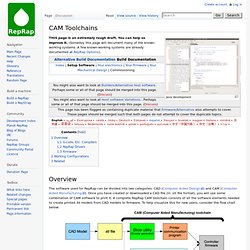
You can help us improve it. (Someday this page will document many of the known-working systems. A few known-working systems are already documented at RepRap Options). This page has been flagged as containing duplicate material that Firmware/Alternative also attempts to cover.These pages should be merged such that both pages do not attempt to cover the duplicate topics. The software used for RepRap can be divided into two categories: CAD (Computer Aided Design) and CAM (Computer Aided Manufacturing). A hypothetical software toolchain process for a new design would be: The lists below contain various toolchain components available and provides a comparison of their features, compatible components and how to get them. It should be noted that a comparison of CAD modeling programs is outside of the scope of this article.
G-code, Etc. RepRap Drivers Firmware Firmware is installed on printer itself. For more details, see List of Firmware. Stoffteddy aus dem 3D-Drucker. 3D-Druck ist längst nicht mehr auf Plastik oder Metall beschränkt.
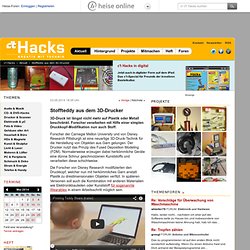
Forscher verarbeiten mit Hilfe einer simplen Druckkopf-Modifikation nun auch Stoff. Forscher der Carnegie Mellon University und von Disney Research Pittsburgh ist eine neuartige 3D-Druck-Technik für die Herstellung von Objekten aus Garn gelungen. Der Drucker nutzt das Prinzip des Fused Deposition Modeling (FDM). Normalerweise erzeugen dabei herkömmliche Geräte eine dünne Schnur geschmolzenen Kunststoffs und verarbeiten diese schichtweise. Die Forscher von Disney Research modifizierten den Druckkopf, welcher nun mit herkömmliches Garn anstatt Plastik zu dreidimensionalen Objekten verfilzt. RepRap Forums. MIT Whizzes Create an Amazing New 3-D Printing Technique. Hyperform translates 3-D CAD models into paths that are populated with a chain of rings that act like pixels.

Each link in the chain has a specialized notch that allows it to be assembled like a Lego kit, in this case creating a chandelier. Photo: Marcelo Coelho The 50 foot long chain was printed in a single piece in a Formlabs 3-D printer that cost just over $3,000. Photo: Marcelo Coelho A couple MIT geniuses figured out how to build a 50 foot chain inside a five inch box. Photo: Marcelo Coelho Hyperform algorithms can creates any kind of shape, including spheres. The project was supported by an Ars Electronica and Voestalpine Art and Technology Grant. The Hyperform software utilizes Hilbert Curves to maximize the use of space within the 3-D printer's build chamber. Hyperform translates 3-D CAD models into paths that are populated with a chain of rings that act like pixels. Thingiverse - Digital Designs for Physical Objects. FABtotum Personal Fabricator. We also believe in the future of personal fabrication as an inspiration for an international, open and cooperative society.
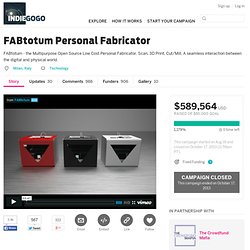
As an Open Source project, FABtotum needs the help of the very people that can understand the consequences of technologically-improved social cooperation, just like any crowdfunding supporter. Funds will be used to start-up the production process and R&D for product and production engineering, allowing us to ship FABtotum in approximately 8 months. Known risks are:Higher production prices due to few units sold, increasing the number of components we have to preorder, reducing our resources. System integrations (especially software/electronics) might require more time than expected. Delivery: digital delivery on your Indiegogo account email. International delivery included. Coupon delivery: digital delivery on your indiegogo account email. Please note: All Coupon codes are not cumulative and will expire if not redeemed before October 1, 2014.
Wandstärke nach Kunststofftyp. Patent-Able. Leaders Of The 3D Printing Revolution. 3D-Drucker Liste - 3Druck.com - alles über 3D-Drucker und Rapid Manufacturing. Diese 3D-Drucker Liste zeigt die uns derzeit bekannten additiven Produktionssysteme.

Diese schlüsseln wir in sechs Kategorien auf: Extruson: FDM, FFF und sonstige ExtrusionsverfahrenPulver: Pulverbasierter 3D-Druck, EBM, SL, SLM, SLS und 3DPJetting: Farb-3D-Druck mittels CJP und MJ (plus Mcor´s Papier 3D-Druck)Resin: SLA, DLP, LCM und SLTSpezial: Essens-Drucker, Bio-Plotter und andere speziellere AnwendungenObsolete: 3D-Drucker und Anlagen, die nicht mehr verfügbar sind Für Hinweise, Korrekturen und Ergänzungen klicken Sie bitte auf das Symbol bei dem jeweiligen Gerät. (c) 3Druck.com – Das Kopieren der Daten ohne schriftliche Genehmigung ist nicht erlaubt. Die Übersicht hat keinen Anspruch auf Richtigkeit und/oder Vollständigkeit. Pwdr - Open source powder-based rapid prototyping machine. Recycling-Roboter für 3D-Druck. Mit dem Filabot lassen sich Kunststoffabfälle zu Rohstoffen verwandeln, die dann wieder in 3D-Printern verwendet werden können.
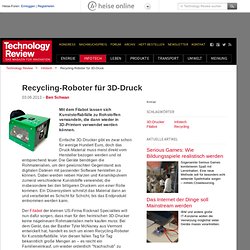
Einfache 3D-Drucker gibt es zwar schon für wenige Hundert Euro, doch das Druck-Material muss meist direkt vom Hersteller bezogen werden und ist entsprechend teuer. Die Geräte benötigen die Rohmaterialien, um den gewünschten Gegenstand aus digitalen Dateien mit passender Software herstellen zu können. Dabei werden neben Harzen und Keramikpulvern zumeist verschiedene Kunststoffe verwendet, die insbesondere bei den billigeren Druckern von einer Rolle kommen. Ein Düsensystem schmilzt das Material dann an und verarbeitet es Schicht für Schicht, bis das Endprodukt entnommen werden kann. German RepRap GmbH - 3D-Drucker für Anspruchsvolle. RepRap Project. RepRap version 1.0 (Darwin) RepRap version 2.0 (Mendel) First part ever made by a Reprap to make a Reprap, fabricated by the Zaphod prototype, by Vik Olliver (2006/09/13) The RepRap project is a British initiative to develop a 3D printer that can print most of its own components.[1] RepRap (short for replicating rapid prototyper) uses an additive manufacturing technique called Fused filament fabrication (FFF) to lay down material in layers; a plastic filament or metal wire is unwound from a coil and supplies material to produce a part.
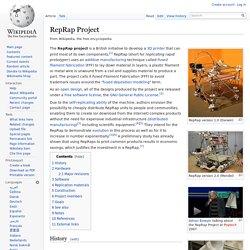
The project calls it Fused Filament Fabrication (FFF) to avoid trademark issues around the "fused deposition modeling" term. As an open design, all of the designs produced by the project are released under a free software license, the GNU General Public License.[2] History[edit] All of the plastic parts for the machine on the right were produced by the machine on the left.
Video of RepRap printing an object RepRap 0.1 building an object 23 March 2005 Summer 2005.
Shop. The fast, easy to build, affordable 3D printer - 3D printing for everyone! The Portable Open Source 3D Printer. Dinge drucken in 3D. Der Bastler des 21.

Jahrhunderts konstruiert 3D-Modelle am PC, schickt sie per Internet zu einem Dienstleister und holt die fertigen Teile wenige Tage später aus dem Briefkasten. Alles passt perfekt, und in den Finger sägt man sich dabei garantiert nicht. Ein Brain Gear ist eine Konstruktion aus 12 Achsen und 24 paarweise gekoppelten Kegelzahnrädern – und eigentlich zu gar nichts nütze.
Trotzdem dient es einer ganzen Branche als dreidimensionale Visitenkarte. 3D Printer. MakerBot Industries. MakerBot Industries is a Brooklyn, New York-based company founded in January 2009 by Bre Pettis, Adam Mayer and Zach "Hoeken" Smith producing 3D printers.

MakerBot builds on the early progress of the RepRap Project. History[edit] 3D Druck aus Salz. Das 3D Printing Forum Open3DP, testete ein Verfahren mithilfe dessen 3D Objekte aus Salz gedruckt werden können.
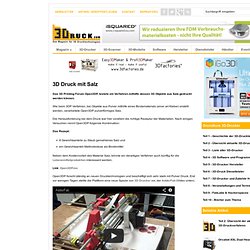
Wie beim 3DP Verfahren, bei Objekte aus Pulver mithilfe eines Bindematerials (einer art Kleber) erstellt werden, verarbeitete Open3DP pulverförmiges Salz. Die Herausforderung bei dem Druck war hier vorallem die richtige Rezeptur der Materialien. Nach einigen Versuchen nennt Open3DP folgende Kombination: Das Rezept: 8 Gewichtsanteile zu Staub gemahlenes Salz undein Gewichtsanteil Maltrodextose als Bindemittel Neben dem Kostenvorteil des Material Salz, könnte ein derartiges Verfahren auch künftig für die Lebensmittelproduktion interessant werden.
Acrylnitril-Butadien-Styrol. Herstellung[Bearbeiten] ABS wird großtechnisch durch Pfropfcopolymerisation hergestellt, es kann aber auch durch Blenden (Vermischen) der fertigen Polymere erfolgen. Bei den durch Pfropfcopolymerisation hergestellten ABS unterscheidet man das Emulsions- und In-Masse-Verfahren: Emulsionsverfahren. Polylactide. Polylactide, die auch Polymilchsäuren (kurz PLA, vom englischen Wort polylactic acid) genannt werden, sind synthetische Polymere, die zu den Polyestern zählen. Sie sind aus vielen, chemisch aneinander gebundenen Milchsäuremolekülen aufgebaut. Erstmals beschrieben wurden Polylactide 1845 von Théophile-Jules Pelouze. Bei dem Versuch, Milchsäure durch Erhitzen und Entfernung von Wasser aufzureinigen, beobachtete er eine Kondensation der Milchsäuremoleküle und die Bildung von Oligomeren und Polymeren.[3] Wallace Hume Carothers, ein Mitarbeiter von DuPont, entwickelte 1932 ein Verfahren zur Herstellung von Polylactiden aus Lactiden, das 1954 von DuPont patentiert wurde.[4] Aus PLA können durch Wärmezufuhr verformbare Kunststoffe (Thermoplaste) hergestellt werden.
Polylactid-Kunststoffe sind biokompatibel. Eigenschaften[Bearbeiten] 3D-Drucken mit Recyclingkunststoff.
3D Models. Wiki. RepRap is humanity's first general-purpose self-replicating manufacturing machine. RepRap takes the form of a free desktop 3D printer capable of printing plastic objects. Since many parts of RepRap are made from plastic and RepRap prints those parts, RepRap self-replicates by making a kit of itself - a kit that anyone can assemble given time and materials. It also means that - if you've got a RepRap - you can print lots of useful stuff, and you can print another RepRap for a friend... RepRap is about making self-replicating machines, and making them freely available for the benefit of everyone.
We are using 3D printing to do this, but if you have other technologies that can copy themselves and that can be made freely available to all, then this is the place for you too. Reprap.org is a community project, which means you are welcome to edit most pages on this site, or better yet, create new pages of your own. Solar-Sintern: Sandschmelzofen als 3D-Drucker. Sintern heißt die Technik, mit der aus Sand oder Pulver durch Erhitzung Gegenstände erstellt werden.
Meist wird dazu ein Laser oder eine ähnlich starke Energiequelle eingesetzt. Markus Kayser setzt auf die Kraft der Sonne. Im ägyptischen Teil der Sahara probierte er seinen Solarofen aus. Die gesamte Konstruktion ist drehbar gelagert, um die Linsen auf die Sonne auszurichten. Die Nachverfolgung geschieht automatisch mit Hilfe eines Sensors und eines Motors, der die Plattform dreht. Den notwendigen Betriebsstrom für den elektrischen und elektronischen Teil seines Solarschmelzofens gewinnt Kayser mit Hilfe von zwei Photovoltaikmodulen. Plastik / Kunststoff : GRRF, German RepRap Foundation. Markus Kayser Builds a Solar-Powered 3D Printer that Prints Glass from Sand and a Sun-Powered Cutter. Industrial designer and tinkerer Markus Kayser spent the better part of a year building and experimenting with two fantastic devices that harness the sun’s power in some of the world’s harshest climates. The first he calls a Sun Cutter, a low-tech light cutter that uses a large ball lens to focus the sun’s rays onto a surface that’s moved by a cam-guided system.
As the surface moves under the magnified light it cuts 2D components like a laser. The project was tested for the first time in August 2010 in the Egyptian desert and Kayser used thin plywood to create the parts for a few pairs of pretty sweet shades. But he didn’t stop there. Next, Kayser began to examine the process of 3D printing. In mid-May the Solar Sinter was tested for a two week period in the deserts of Siwa, Egypt, resulting in the amazing footage above. EOS Electro Optical Systems.